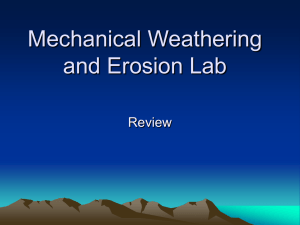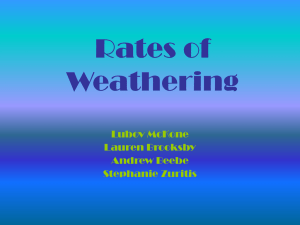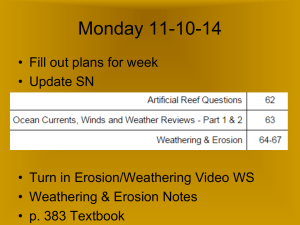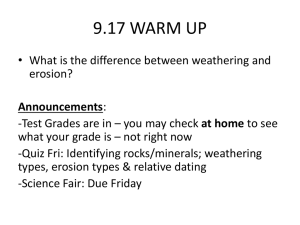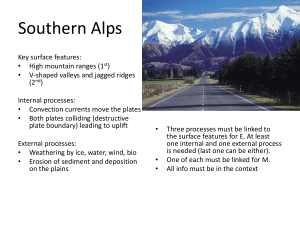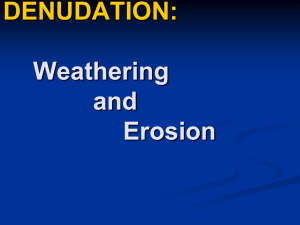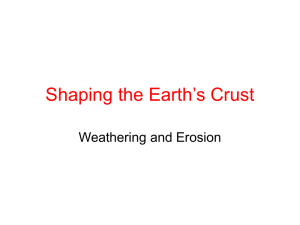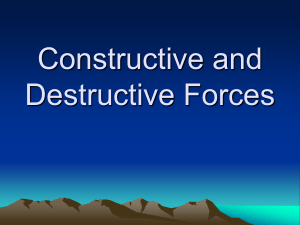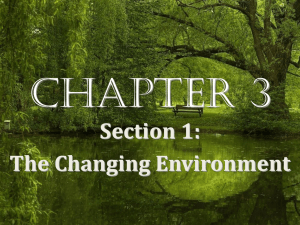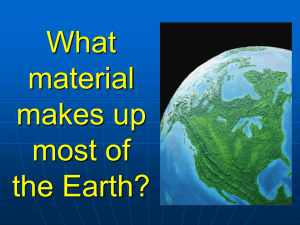Weathering Process
advertisement
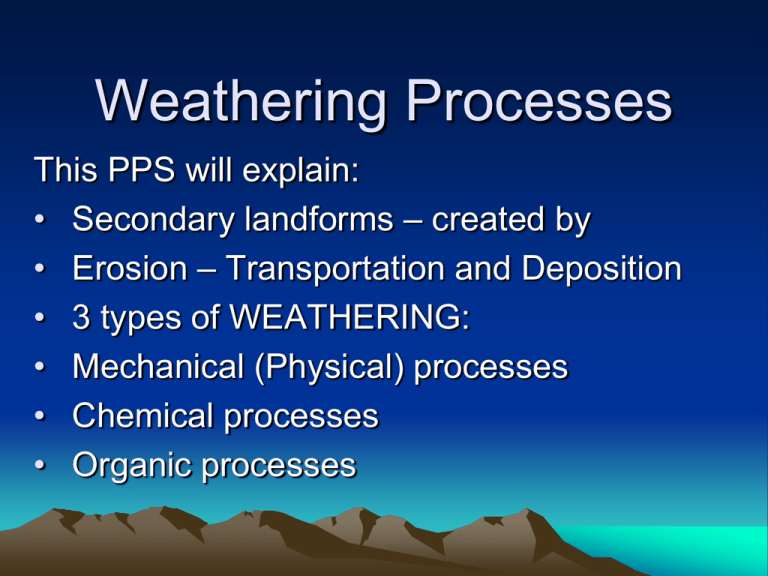
Weathering Processes This PPS will explain: • Secondary landforms – created by • Erosion – Transportation and Deposition • 3 types of WEATHERING: • Mechanical (Physical) processes • Chemical processes • Organic processes Your task • As you watch this PPS you need to record information in your books or on a word document. • Later on you will be given a task that requires you to find your own examples of these processes. What do the following photos have in common? The photos all show weathering processes • Secondary landscapes are formed through weathering processes. • These processes act continually upon the landscape. • They slowly change the shape and appearance of the landscape. • The three processes are weathering, erosion and mass movement. Weathering • Is the breakdown of rock in the place it was found, by the action of weather chemicals, gravity (glaciers), plants and animals. Erosion Rivers, waves, ice and wind transport rocks, rock fragments and soil away and deposit them somewhere else. Mass Movement When rocks, loosened by weathering move downhill under the influence of gravity. Transportation Is the movement of materials by weathering processes: Wind, rain, running water, wave action and gravity. Deposition/ aggradation Is the deposition of material, which can lower relief in differences of high and low points in a landscape. Streams, glaciers, wind, and waves also deposit materials. Mechanical Weathering Frost action is a type of weathering where water actually seeps into cracks in the rock. The water freezes as the temperature drops. As water freezes it expands. Geography4kids website This expansion creates a wedge inside the rock, encouraging is to crack and split apart. This picture shows one of those fractures. Mechanical Weathering Salt wedging. As water enters the holes and cracks in the surface of rocks, it often carries salt with it. As the water later evaporates, the salt is left behind. After a while, salt crystals grow and create wedges that force the rock apart. Mechanical Weathering Glaciers are extremely effective weathering and erosional agents. A glacier is capable of carving deep valleys into bedrock as well as scraping all loose material (soil and weathered bedrock) off from a landscape. Click on the link below to view a Youtube clip of Mass movement and gravity in action. https://youtube.googleapis.com/v/zt8qoggxWVg Erosion – Mass Movement Talus Cone, Lake Louise, Canada. Talus cones are rock falls, which are driven by gravity, it is one of the main ways by which cliffs erode. As fractures in the bedrock grow, large blocks of rock can break off and accumulate below. If rock fall is concentrated anywhere, then a coneshaped deposit will form. Chemical Erosion Chemical solutions act to break down rock, such as when calcium carbonate is subjected to humid conditions and dissolves to form limestone. Chillagoe caves Click on the link below to view a Youtube clip of chemical and mechanical weathering processes https://youtube.googleapis.com/v/P8oWj3PVK9E?start=155&end=339&autoplay= 1&loop=1 Karst Is an example of a landscape formed mainly by a chemical process - rock being dissolved by surface or groundwater. 2 key ingredients: Rock (typically limestone) + Water LIMESTONE QUARRY Which process is shown in this photo? Weathering – rain and wind Which process is shown in this photo? Weathering – wave, salt wedging, mass movement Erosion - transportation Which process is shown in this photo? Weathering – Gravity, Mass movement, Talus cones Which type of weathering is most likely to… • Occur in a tropical climate? • Chemical, mechanical weathering and erosion • Happen in Cairns more in the summer than winter? Mechanical weathering and erosion • Happen fastest in a tropical rainforest? – Chemical (moss and lichen) and mechanical weathering (tree roots cracking rocks)

